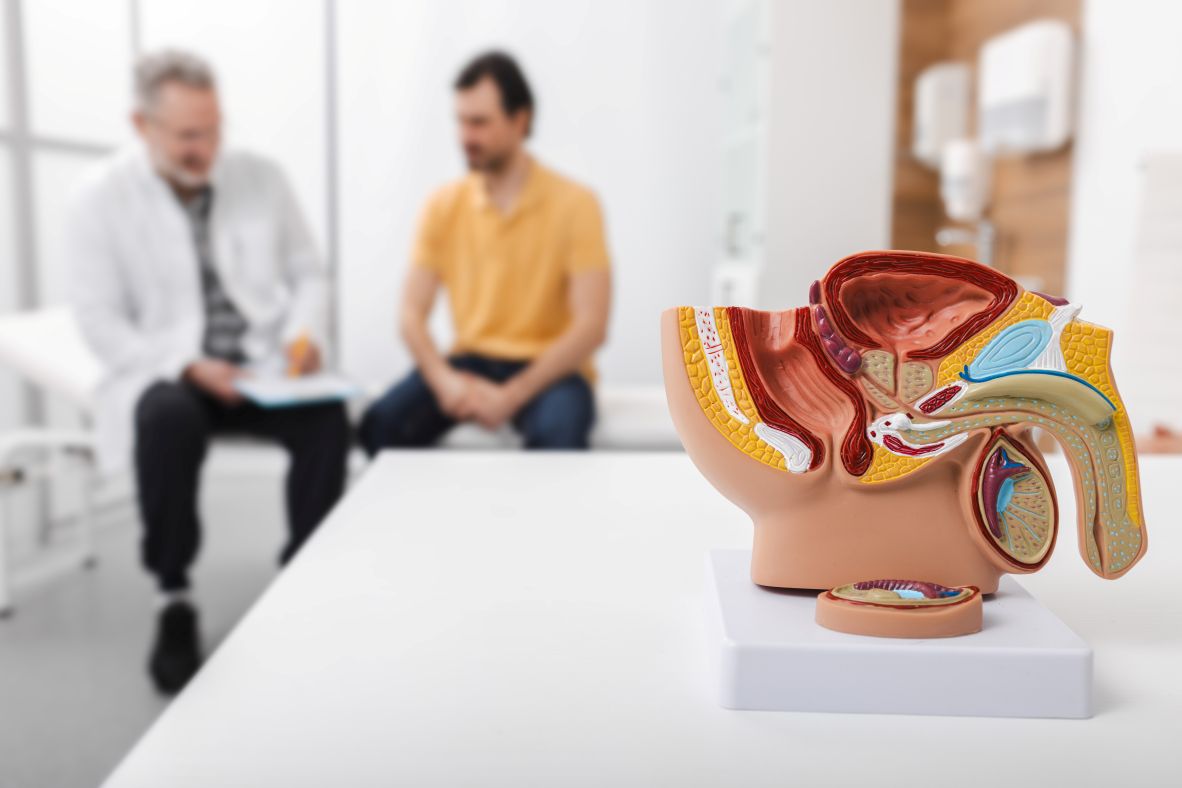Since the 1940s, there have been conflicting theories and conclusions surrounding testosterone replacement therapy (TRT), and whether or not it is safe for hypogonadal men with or without a history of radically treated prostate cancer (PCa). This article will go over some international guidelines and recent research on how to approach TRT in hypogonadal PCa patients.
History
Until more recently, many urologists were under the impression that TRT would cause rapid growth or regrowth of PCa in patients. This is due to research by Huggins and Hodges demonstrating that reducing testosterone levels can cause regression of metastatic cancer growth, while the presence of exogenous androgenetic hormones could cause growth. However, more recent studies suggest this may not be entirely accurate, particularly in patients without metastatic prostate cancer.
Guidelines
In 2018, the American Urological Association (AUA) released guidelines (endorsed by the International Society for Sexual Medicine) stating that TRT should be available to hypogonadal PCa patients on a case-by-case basis. They also recommend there is full transparency about the inconsistent evidence. Meaning, patients should be aware that there is no evidence that TRT may cause cancer growth, however there is a lack of long-term data to reflect this statement. They state that hypogonadal patients with PCa should not be deprived of the opportunity of TRT. The specific AUA guidelines are as follows:
- Goal total testosterone within the middle tertile (450-600 ng/dL).
- All patients should be closely followed for efficacy and side effects with routine labs, around every 3-6 months.
- For men that have baseline testosterone levels below considered saturation of 250 ng/dL monitor PSA levels, especially right after beginning TRT (4 weeks, monthly for 3 months, at 3 months, 6 months, and every 6 months after).
- Consider gels (if low transference risk) or shorter acting injections at the outset. Long term options like pellets or Aveed are more difficult to stop if PSA levels rise, or scans show PCa growth.
- Consider having patients sign a more formal consent form prior to TRT to acknowledge later. This would include the full discussion of research findings, side effects, and commitment to the testosterone program.
As many testosterone symptoms are heterogeneous and nonspecific, consider exploring commonly reported symptoms including fatigue, low libido, erectile dysfunction, exercise intolerance, mood swings etc. for other causes such as mental health or alternative physiological issues.
It is useful to note that guidelines are variable. Similarly to AUA guidelines for TRT, the Canadian Medical Association Journal considers patients treated for localized PCa with no evidence of active disease as candidates for TRT. However, the Endocrine Society advises against TRT in patients with an unevaluated prostate nodule, PSA >4ng/mL, or in high-risk patients with PSA >3ng/mL. This literature is not based on any current or updated data. However, treatment with TRT should be meticulous and managed as a multidisciplinary approach with patient’s urologist or oncologist.
Other Recommendations
- TRT should be avoided in men who desire fertility. Regardless of age or PCa, fertility assessment needs to be examined before starting exogenous testosterone.
- Never start exogenous testosterone until all confounders have been ruled out i.e prolactinomas.
- Use a multidisciplinary approach, consulting with other care professionals who are working with your patient.
Key Points
- TRT is generally safe for hypogonadal patients with PCa as long as clinicians closely monitor PSA levels and patients are made aware of all the potential risks and benefits.
- Always consult with patients and other departments prior to starting a PCa patient on TRT. Patients should be aware of the lack of long-term data surrounding testosterone and prostate cancer and the need for more randomized control studies in the field.
- Clinicians should be aware of the guidelines in their area of practice and the constantly evolving research about TRT and its effect on PCa.
References:
Hilton, L. (2023, January 5). How testosterone therapy use in men with prostate cancer has evolved. Urology Times. https://www.urologytimes.com/view/how-testosterone-therapy-use-in-men-with-prostate-cancer-has-evolved
Ramasamy, R., Fisher, E., & Schlegel, P. (2012). Testosterone replacement and prostate cancer. Indian Journal of Urology, 28(2), 123. https://doi.org/10.4103/0970-1591.98449
Ziegelmann, M. J., & Collins, C. S. (2023, September 19). PROSTATE CANCER Testosterone Replacement After Definitive Prostate Cancer Treatment: Where Do We Stand?. AUA News. https://auanews.net/issues/articles/2023/september-extra-2023/prostate-cancer-testosterone-replacement-after-definitive-prostate-cancer-treatment-where-do-we-stand
You may also be interested in...
Other Popular Articles

What Is the Average Penis Size?
If you have ever wondered how your penis compares to others in terms of size, you are not alone. Many men are curious to know how their penises stack up compared to the average. Unfortunately, general curiosity can sometimes give way to full-on obsession and anxiety about penis size. This can be an unhealthy and often unnecessary fixation, especially because most men who think their penises are too small have perfectly normal-sized penises.

What Is Jelqing, and Does It Actually Work?
The term “jelqing” refers to a set of penis stretching exercises that some believe can make the penis bigger. Although the practice has gained attention and popularity in blogs and internet forums in recent years, there is no scientific evidence that it is an effective way to permanently increase the size of one’s penis. In fact, in some cases, jelqing may actually cause damage to the penis, so it is a good idea to get all the facts before setting off to try it.

What Is Sensate Focus and How Does It Work?
Sensate focus is a technique used to improve intimacy and communication between partners around sex, reduce sexual performance anxiety, and shift away from ingrained, goal-oriented sexual patterns that may not be serving a couple.

Can Sex Reduce Menstrual Cramps?
The SMSNA periodically receives and publishes ‘guest editorials.’ The current article was submitted by Mia Barnes, a freelance writer and researcher who specializes in women's health, wellness, and healthy living. She is the Founder and Editor-in-Chief of Body+Mind Magazine.
Having sex while you experience menstrual cramps is healthy and can provide significant benefits. While it might not be the first activity that comes to mind when your PMS or period cramping begins, many people enjoy sex to reduce menstrual cramps, experience increased pleasure and benefit from other advantages. Learn more about having sex while menstrual cramps are happening and how it can help your body.

How Long Does It Take the Average Man to Ejaculate?
On average, it takes a man between 5 to 7 minutes to orgasm and ejaculate during sexual intercourse.

The Effect of Regular Aerobic Exercise on Erectile Function
Erectile dysfunction (ED) is the inability to achieve or maintain an erection sufficient for satisfactory sexual activity. As men get older, their erectile functioning may naturally decline due to changes in testosterone levels, cardiovascular functioning, and the potential development of other chronic medical conditions that become more common with age.
You are prohibited from using or uploading content you accessed through this website into external applications, bots, software, or websites, including those using artificial intelligence technologies and infrastructure, including deep learning, machine learning and large language models and generative AI.


